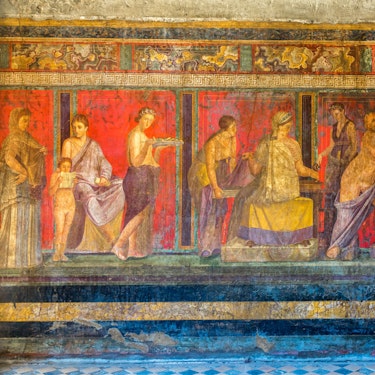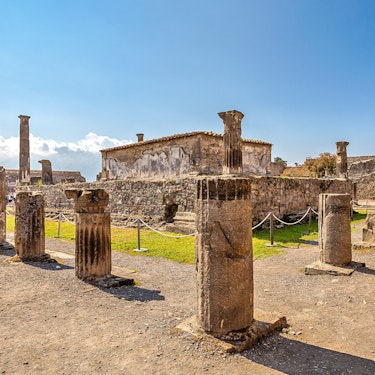More about: Best Things To Do in Pompeii
Pompeii leaves no one indifferent: it is hard to believe that this city petrified by the lava of Vesuvius was almost two thousand years ago a place full of life in the middle of the Roman Empire. The eruption of the volcano paralysed the daily life of its streets and people, leaving the panorama we see today.
Thanks to how well its remains have been preserved and the hard work of historians and archaeologists throughout history, today we can reconstruct what the social life and customs of Pompeii's citizens were like. Take note of the must-sees if you are planning a trip to Pompeii.
1. Walk through its cobbled streets to discover the city that was buried under lava

As soon as you arrive you will see the immensity of the archaeological site, which was the one that was completely petrified. Before you begin your exhaustive visit and dedicate yourself to discovering each and every nook and cranny, take the opportunity to familiarise yourself with the area, enjoy the panorama of its streets with Vesuvius in the background?
If you have arrived here early in the morning, it will not be too crowded yet and the silence of the early hours of the day will make you travel back in time just by strolling through the ancient streets of the city.
If you plan to do the visit on your own, without a guide or audio guide, it is a good time to familiarise yourself with a map and try to locate the main key attractions of the city and mark the itinerary that you will follow for the rest of the day.
2. Marvel at its amphitheatre

Did you know that the Roman amphitheatre in Pompeii is the oldest surviving Roman amphitheatre in the world? The famous Colosseum in Rome was built almost a century after it! For that alone it is worth an exclusive visit.
An important part of the social and leisure life of the city took place here, with shows, games and, of course, battles. This amphitheatre could hold up to 20,000 people in the audience. At first glance, it is not as large or as striking as the Colosseum in Rome; the stands are smaller and at its base there is only grass and sand.
Even so, you can get inside without any problem and I assure you it is well worth it. Put it on your list of things to see on your tour of Pompeii.
3. Don't miss any of the highlights

The Forum
Strolling through the forum you will see the remains of columns and other constructions that were erected in the most social part of the city. The remains of columns, statues and temples help us to get an idea of the majestic size of some of the monuments and buildings of the time.
The Temples
Religion was fundamental to the citizens of the time and they spent much of their free time praying in temples. Throughout the tour of the city of Pompeii you will see the remains of some of them, the Temple of Apollo being the oldest and most important: it was built between the 8th and 7th century BC and today little remains of its structure, but it is well worth a visit to see it.
The thermal baths
Throughout the city of Pompeii there were several thermal baths (or public baths) where much of the social life of the city also took place. Remains of several of them are still preserved, but without a doubt the best preserved are the "Terme Sabiane", so if you have time to stop at one of them, don't hesitate and do it in these.
The Lupanar
By now you will have realised that leisure and social life occupied a large part of the time of the citizens of Ancient Rome and of course, the same was true of Pompeii. In their daily life, citizens participated in shows, meetings, religious celebrations, etc. where they met with other citizens (always divided by social classes) and this place is proof of that.
The Lupanar is an old brothel where the citizens used to go frequently. Nowadays it is quite well preserved and you can go inside. Note that some mosaics and the beds (now petrified, of course) are still preserved. Incredible but true!
Its theatres (Teatro Grande and Teatro Piccolo)
Both are still very well preserved. They were once used for theatrical performances and today the Teatro Grande still hosts live events. Can you imagine attending a small concert or a play in a theatre with two centuries of history?
Don't be fooled by its name, although it is called Teatro Grande, the capacity is only 5,000 people and when there is an event, the atmosphere is very intimate and special. Check the theatre's official website for the programme in case you are lucky enough to catch an event during your visit to Pompeii.
The mosaics and details of the Faun's House
As one of the most majestic houses preserved in the city, a visit to the House of Faun is a must. It is estimated to have been built in the 2nd century BC. It was once one of the richest and most luxurious villas in the city and its interior housed true works of art that are still preserved today. Some of them have been moved to the Archaeological Museum of Naples, but inside you can still see some statues and mosaics that are worth a visit.
4. Marvel at the human remains petrified by lava

One of the places that most attracts the attention of visitors to Pompeii is the Orto dei Fuggiaschi (or the "garden of the fugitives" in English). Here you can see the petrified bodies of 13 people (adults and children) who tried to flee the lava of Vesuvius during its eruption.
If you are worried that these figures may offend your sensibilities, the truth is that although you can see the bodies of the figures perfectly, the fact that they are covered in stone reduces the detail of the image, so this should not be a problem.
5. Enjoy the delicious gastronomy of the area

It is a fact that Italy is a great place to eat, but if you go to the Naples area, the food is even better. The cuisine in the birthplace of pizza is a delight, and you can't leave Pompeii without enjoying a good typical meal.
But as in many places frequented by tourists, there is also a proliferation of fast-food outlets or overpriced restaurants that do not offer sufficient quality. That's why I've put together a list of the best places to eat in Pompeii that are not to be missed.
If you're visiting on your own or on a non-food tour, take a look at the list and book in advance to ensure you get a table at the best places and leave Pompeii with a good taste in your mouth. You'll find plenty of pasta and pizza, but also Mediterranean cuisine, mixed dishes and a wide variety of ice creams, sweets and desserts if you prefer a snack or an afternoon snack to replenish your energy after your visit.
6. Get the most out of your visit with children

Visiting Pompeii with children is a great idea, but like everything else, it has its tricks. You'll be outdoors for practically the whole day, so you'll need to protect your little ones from both the cold and the heat. Comfortable shoes will be your best ally, and carrying some snacks in your backpack is a highly recommended lifesaver.
In addition to all this, I recommend that you tell them something about the history of Pompeii before the visit, so that they know what they are going to see (the history of volcanoes usually fascinates children) and this will keep them entertained.
Apart from these tips for visiting Pompeii with kids, I also recommend you to read my article with the best tips for visiting Pompeii and getting the most out of your tour of the ruins of Vesuvius.
7. Climb the crater of Vesuvius

The reason why millions of people still visit Pompeii today is undoubtedly Vesuvius, which when it erupted almost two thousand years ago paralysed the life of the city, leaving its buildings and inhabitants buried under the lava.
Just over 20 kilometres from Pompeii, the Vesuvius National Park is open to visitors, who can hike up Vesuvius for the best views of the area and a breathtaking view of the volcano.
There are some excursions from Naples to Pompeii and from Rome which, in addition to visiting the ruins, include a climb up Vesuvius and are 100% recommended. Travellers visiting the area on their own can also get there by bus, private car or even taxi to make the climb to the top. If you're looking for something a little different, there are even some very interesting horseback riding activities on Vesuvius. As you can see, there are many ways to see this incredible volcano.
8. Immerse yourself in the culture of Pompeii with a guided tour.

If you are hesitating between visiting a monument or attraction on your own or with an expert guide, for me there is no comparison: the experience is much better when they tell you and explain what you are seeing, give you details about the context and history of the place and immerse you in its culture.
In Pompeii, a city with such a tragic history behind it and a culture as relevant and distinct as that of the Roman Empire, taking a guided tour or an audio guide is a must.
Fortunately, the tourist demand to visit Pompeii is such that you will find numerous possibilities to join an organised excursion to Pompeii from Rome or an all-inclusive excursion to Pompeii from Naples. If you plan to get there on your own, when buying tickets to Pompeii find out if there is a way to pay extra and have a specialised guide or take the audio guide offered at the entrance.
9. Visit neighbouring Naples

Naples is one of the most visited cities in Italy. Its spectacular streets and squares, its authentic neighbourhoods such as the Quartiere Spagnolo, its sea views and its exceptional cuisine make it a tourist hotspot that few travellers want to miss.
It's just over half an hour from Pompeii and can be reached by plane, train or road, so there's no excuse for leaving it off your itinerary.
Near Naples you have fairytale island paradises such as Ischia, Procida and Capri, and the picturesque Amalfi Coast, with its endless cliffs of colourful houses that will steal your heart. Even the cities of Salerno and Sorrento, from where excursions to Pompeii also depart.
10. Complete the tour with a visit to Herculaneum

Herculaneum is another of the historic cities that fell victim to the eruption of Vesuvius. Right at the foot of the volcano was this rich and prosperous city that had better constructions and buildings than Pompeii itself. Everything was destroyed and petrified under the lava, but today it is also possible to visit its archaeological remains, which are very well preserved.
If you plan to climb Vesuvius, you will have to follow the road that passes through Herculaneum, so it is the perfect excuse to take a break and enjoy a stroll through this city that was also frozen in time in 79 AD.














